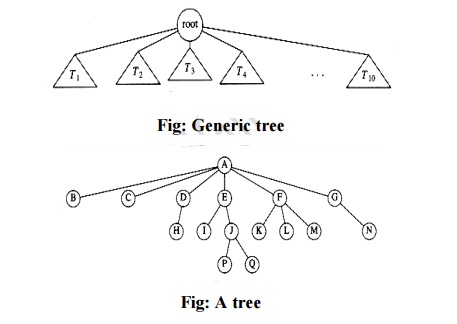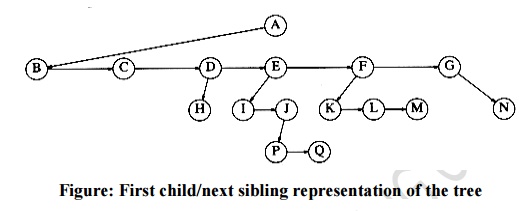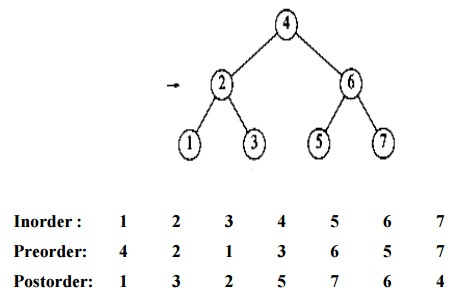Chapter: Programming and Data structures : Advanced Non-Linear Data Structures
Tree Introduction
TREE
INTRODUCTION
Tree
A tree is
a collection of nodes. The collection can be empty; otherwise a tree consists
of a specially designed node called root,
and one or more non empty sub trees T1, T2, ŌĆ”, Tk,
each of whose roots are connected by a directed edge from root.

Root
The root is the first and top most nodes in the
hierarchical arrangement of data items. A node which does not have a parent
node is called root node. In the above tree, the root is A.
Node
Each data item present in the tree is called a node. It is the basic data structures
that specifies the data information and have links to other data items. Example
node A, B, ŌĆ”..,,
Q.
Leaf
A node
which doesnŌƤt have children is called leaf
or Terminal node. In the above tree B, C, H, I, K, L, M, N, P, Q are leaf
node.
Siblings
Children of the same parents are said to be siblings. In the above tree B, C, D, E,
F ,G are siblings, I,J are siblings, K, L, M are siblings, P, Q are siblings.
Path
A path from node n1 to nk
is defined as a sequence of nodes n1,
n2, . . . , nk such that ni is the parent of ni+1 for 1 <= i <= k.
There is
exactly only one path from the root to each node. In the above tree the path
from A to P is A, E, J, P. Where A is the parent for E, E is the parent of J,
and J is the parent of P.
Length
The length is defined as the number of edges on the path. The length for the path A to P is 3.
Degree
i. Degree of a node
The number of sub trees of a node is called its degree. In the above tree, degree of A
is 6, degree of F is 3, and degree of B is 0.
ii. Degree of a tree
The degree of the tree is the maximum degree of any
node in the tree. In the above tree, the degree of the tree is 6.
Level
The level of a node is defined by initially letting
the root be at level one. If a node is at level L then its children are at
level L+1.
In the previous tree, the level of A is 1, level of
B, C, D, E, F, G is 2, level of H, I, J, K, L, M, N is 3, and the level of P, Q
is 4.
Depth
For any node n, the depth of n is the length of the
unique path from root to n. For example, the depth of root A is 0, depth of c
is 1, depth of H is 2, and the depth of P is 3
Height
For any node n, the heig ht of the node n is the
length of the longest path from n to the leaf. The height of the leaf is zero.
For example, the height of node F is 1, and the height of E is 2.
Note
├ś The
height of the tree is equal to the height of the root.
├ś Depth of
the tree is equal to the height of the tree.
Terminal node
A node with degree zero is called a terminal node. Leaf is called the
terminal node because it has the degree 0. In the previous tree node B, C, H,
I, K, L, M, N, P, Q are terminal nodes.
Non ŌĆō Terminal Node
Any node whose degree is non zero is called Non ŌĆō Terminal node. In the
previous tree node A, D, E, F, G, J are non terminal nodes.
Edge
An edge is a condition line which connects two
adjacent node of a tree. The line drawn from one node to another node is called
edge. If a tree has N nodes, then
there are N-1 edges. For example, the previous tree has 13 nodes and 12 edges.
Interior node
A node is said to be an interior node only if it is
between root and leaves. All non terminal nodes except the root is called
interior node. For example, D, E, F, G, J are interior nodes.
Ancestor node
A node is said to be an ancestor of another node
only if it is the parent of that node or the parent of same ancestor of that
node. For example, the ancestor of node H are A and D, and the ancestor of node
F is A.
Descendent node
A node is said to be a descendent of another node
if it is the child of that node or the child of some other descendent of that
node. For example, the descendent of F are K, L, M, and the descendent of E are
I, J, P, Q.
Forest
A forest is a set of disjoint trees. If the root is
removed, then each node becomes a separate tree to become a forest.
Implementation of Trees
One way
to implement a tree would be to have in each node, besides its data, a pointer
to each child of the node. However, since the number of children per node can
vary so greatly and is not known in advance, it might be infeasible to make the
children direct links in the data structure, because there would be too much
wasted space. The solution is simple: Keep the children of each node in a
linked list of tree nodes.
typedef
struct tree_node *tree_ptr;
struct
tree_node
{
element_type
element;
tree_ptr
first_child;
tree_ptr
next_sibling;
};

In the
above fig, arrows that point downward are first_child
pointers. Arrows that go left to right are next_sibling
pointers.
Tree Traversals
Tree
traversal is a method for visiting all the nodes in the tree exactly once.
There are three types of tree traversal techniques, they are
i.
Inorder Traversal
ii. Preorder
Traversal
iii.
Postorder Traversal
Inorder Traversal
The
inorder traversal of a binary tree is performed as
├ś Traverse
the left subtree in inorder
├ś Visit the
root
├ś Traverse
the right subtree in inorder.
Recursive routine for inorder traversal
void
inorder(Tree T)
{
if(T!=NULL)
{
inorder(T->left);
printElement(T->Element);
inorder(T->right);
}
}
Preorder Traversal
The
preorder traversal of a binary tree is performed as
├ś Visit the
root
├ś The left
subtree in preorder
├ś Traverse
the right subtree in preorder.
Recursive routine for preorder traversal
void
preorder(Tree T)
{
if(T!=NULL)
{
printElement(T->Element);
preorder(T->left);
preorder(T->right);
}
}
Postorder Traversal
The
postorder traversal of a binary tree is performed as
├ś Traverse
the left subtree in postorder
├ś Traverse
the right subtree in postorder.
├ś Visit the
root
Recursive routine for postorder traversal
void
postorder(Tree T)
{
if(T!=NULL)
{
postorder(T->left);
postorder(T->right);
printElement(T->Element);
}
}
Example

Inorder : 1 2 3 4 5 6 7
Preorder: 4 2 1 3 6 5 7
Postorder: 1 3 2 5 7 6 4
Related Topics